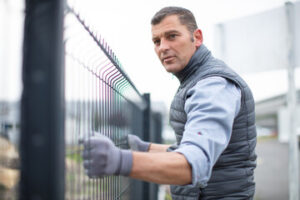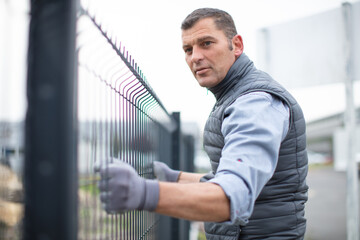Before starting any fence project, call 811 and have all buried utility lines mapped out. This is particularly important for metal fencing, as holes can easily damage water pipes, telephone wires, and other underground services. Purchase a fence kit that includes end, corner, and line posts. For professional expertise, contact Pro Angle Fencing Summerville.
 There are a few factors that determine the cost of metal fencing installation. The type of fencing material that is chosen is one important consideration. Iron fences, for example, typically cost more than aluminum. The height of the fence also impacts the overall cost. The number of gates and their style is another factor. For example, a 3-ft gate costs more to install than a 1-ft gate. The terrain where the fence will be installed is another factor. For instance, if the area is on a slope, installing the fence will require more labor.
There are a few factors that determine the cost of metal fencing installation. The type of fencing material that is chosen is one important consideration. Iron fences, for example, typically cost more than aluminum. The height of the fence also impacts the overall cost. The number of gates and their style is another factor. For example, a 3-ft gate costs more to install than a 1-ft gate. The terrain where the fence will be installed is another factor. For instance, if the area is on a slope, installing the fence will require more labor.
When choosing a metal fence, it is important to consider the style that will be best for your property and needs. There are a variety of different styles, including decorative, security, and pool. Some styles are more durable than others, and some offer a more stylish look. It is also a good idea to consider whether you need additional features, such as privacy screens or gated entries.
The metal fencing installation process usually involves placing the fence poles in the ground, then installing the panels affixed to the poles. The installation team will then place gates where necessary. Before starting, the installers will need to check for any buried utilities in the area where the fence will be located. This will help avoid damage to pipes and wires during the installation process. The contractor will also need to notify the utility companies before digging. This can be done by calling 811 and speaking to an operator.
A metal fence can be an investment, but it will last for years and provide security for your home and property. Some homeowners choose to save money by opting for a lower quality metal fence, but this may lead to more maintenance and a shorter lifespan for the fence. If you are concerned about the longevity of your metal fence, consider having it galvanized or coated with zinc. This will protect the metal from rust and reduce your maintenance costs in the long run.
If you are considering a metal fence, be sure to get a quote from a reputable professional. They will be able to recommend the right style and materials for your property. They will also be able to give you an accurate estimate of the installation cost.
Materials
Whether you want a traditional picket fence or something more ornate, there’s a metal fencing solution that fits your budget. The key is to know how much materials are required for your project before you start shopping. First, measure the perimeter of your yard to determine how many linear feet of fencing you need. Then select the specific materials you’ll need to purchase.
The basic material for most metal fences is aluminum or steel. You can find these in a wide range of heights and colors, as well as decorative elements. You’ll also need posts to hold the fence upright, and the horizontal beams called rails to connect the pickets or panels.
If your fence will be in a windy area or exposed to snow and rain, consider galvanizing the iron. This adds $2 to $4 per foot to the upfront cost but will save you money in the long run, as it reduces maintenance costs by protecting the metal from rust.
Other common metal fence materials include wrought iron, chainlink mesh and electro-welded mesh. Wrought iron offers beauty and strength, but can be expensive, especially if you choose an ornate design. Metal fencing can also be woven together to create a custom fence design, although this may increase installation costs.
A metal fence isn’t a DIY project for most homeowners, as it requires special tools and knowledge of proper installation techniques. However, if you are skilled and have the time, you can save money by installing your fence yourself. Just be sure to follow the manufacturer’s instructions exactly.
If you are using a metal fence to separate your property from someone else’s, then you must check for underground pipes and cables in the vicinity before digging holes for the posts. Otherwise, you risk damaging them with the posts. If the land has a severe slope then you might need to stair-step the fence, with each panel installed a little higher than the last along the slope.
If the fence is to be made of a softer material such as wood, it needs to be treated with a chemical preservative. Otherwise, it will rot and become a safety hazard. Wrought iron fences need to be regularly checked for rust spots, which can spread quickly if not attended to promptly. Cleaning the surface with a wire brush, applying a rust-preventative paint or wax and touching up the finish with touch-up spray is an important part of keeping your fence looking its best.
Installation
The cost of installing metal fencing can be impacted by several factors. The type of fence selected will affect the labor cost, but so will the terrain and whether regrading is needed. If a gate is included in the design, that will also add to the labor cost. Finally, the materials chosen will have an impact on price as well. Some types of metal fences are relatively simple to install, but others require specialized tools and installation techniques. For that reason, it’s best to leave this type of project to the pros.
Before digging any holes, it’s a good idea to map out the entire fence layout using wooden stakes for each corner, end and gate post location. This will serve as a straight line guide for the posts to be installed and help ensure that the fence is correctly aligned. After locating the locations for each post, the installer will dig the hole and set the post with concrete. The hole should be a few inches deeper than the bare minimum to make sure that it’s secure in the ground.
Fence rails are then connected to the posts by a system of brackets. The brackets should be tightened until the rail is properly secured and the tension is sufficient to keep the rail from shifting or pulling away from the post. The next step is to stretch a bottom tension wire, sometimes called coil wire or “coil” wire, between the terminal posts, which helps minimize in-and-out movement at the bottom of the fence. For taller fences, 10 feet or more, a top tension wire may be added.
Once the bottom tension wire is in place, the installer will install and stretch a wire mesh that is tightly fixed to the poles, usually with iron wire. The installer will then connect the netting to the bottom tension wire and, when necessary, to the terminal posts with steel or aluminum wire with hooks on one end, which are called fence ties. The ties should be firmly hooked to the posts, and the installer will trim off any excess mesh from the ends of the fence to avoid a hazardous condition that could present a risk of injury.
Maintenance
Wrought iron fences are highly durable and long-lasting, but they require regular maintenance to prevent rust and other damage. The first step in maintaining a wrought iron fence is to wash it thoroughly. This process helps to remove dirt and salt, which will make it easier to see if the wrought iron is starting to show signs of rust. The washing can also help to prepare the fence for repainting, as it will help the new coat of paint to adhere better.
Once the wrought iron has been washed, it is time to apply a protective coating. This can be done with a spray-on galvanization coating, such as the one available from Rust-Oleum (Stops Rust). This coating will help to protect the metal and keep it from rusting in the future. This will cost an additional $2 to $4 per linear foot, but it will save you from costly repairs and replacements in the future.
The next step in maintaining a wrought iron fence involves regularly inspecting the entire fence for problems. This includes looking for loose boards or sagging sections, as well as checking the hardware and hinges to make sure they are working properly. You should also look for areas of rust or corrosion on the fence. This will allow you to catch problems early and address them before they become more serious.
If the fence is damaged, you can repair it yourself or hire a professional. The cost of the repair depends on what part of the fence is damaged, how extensive the damage is, and whether you need welding services. On average, aluminum and steel fencing repairs will cost you $40 to $60 an hour for labor with each panel requiring about an hour of work.
When repairing a fence, it is important to follow proper safety procedures when welding. This includes wearing a welding mask and safety goggles, using a welder in an open area with nothing flammable nearby, and using a welder that is suitable for the job. This will ensure that the weld is strong and will not cause any further damage to the fence.
